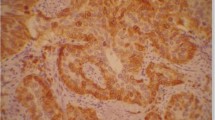Abstract
Specimens from 47 cases of anal squamous-cell carcinoma were examined in Stockholm county (1978 to 1981) with respect to clinical stage (43 cases), histologic grade (41 cases), and DNA content of the tumor cells (31 cases). Follow-up ranged from four to seven years (median, 5.5 years). The increased mortality in advanced stage and high-grade lesions was significant. Analysis of DNA content showed that most tumors were aneuploid. No statistically significant effect of DNA content on survival could be demonstrated. Thus, histologic grade and clinical stage seem to be the best predictors of patient outcome in squamous-cell carcinoma of the anus.
Similar content being viewed by others
References
Beahrs OH, Wilson SM. Carcinoma of the anus. Ann Surg 1976;184:422–8.
Golden GT, Horsley JS III Surgical management of epidermoid carcinoma of the anus. Am J Surg 1976; 131:275–80.
Goldman S, Ihre T, Seligson U. Squamous-cell carcinoma of the anus: a follow-up study of 65 patients. Dis Colon Rectum 1985;28:143–6.
Papillon J. Rectal and anal cancers: conservative treatment by irradiation—an alternative to radical surgery. New York: Springer-Verlag, 1982:201.
Glimelius B, Graffman S, Påhlman L, Wilander E. Radiation therapy of anal carcinoma. Acta Radiol Oncol 1983;22:273–9.
Auer G, Caspersson T, Wallgren A. DNA content and survival in mammary carcinoma. Anal Quant Cytol Histol 1980;2:161–5.
Atkin NB, Richards BM. Clinical significance of ploidy in carcinoma of cervix: its relation to prognosis. Br Med J [Clin Res] 1962;2:1445–6.
Gaub J, Auer G, Zetterberg A. Quantitative cytochemical aspects of a combined Feulgen-Naphthol Yellow S staining procedure for the simultaneous determination of nuclear and cytoplasmic proteins and DNA in mammalian cells. Exp Cell Res 1975;92:323–32.
Adams LR. A photographic cytophotometric method which avoids distributional error. Acta Cytol 1968;12:3–8.
Peto R, Pike MC, Armitage P, et al. Design and analysis of randomized clinical trials requiring prolonged observations of each patients. II. Analysis and examples. Br J Cancer 1977;35:1–39.
Cohn K, Bäckdahl M, Forslund G, et al. Prognostic value of nuclear DNA content in papillary thyroid carcinoma. World J Surg 1984;8:474–80.
Erhardt K, Auer G, Björkholm E, et al. Prognostic significance of nuclear DNA content in serous ovarian tumors. Cancer Res 1984;44:2198–2202.
Bennington JL, Mayall BH. DNA cytometry on four-micrometer sections of paraffin-embedded human renal adenocarcinomas. Cytometry 1983;4:31–9.
Author information
Authors and Affiliations
About this article
Cite this article
Goldman, S., Auer, G., Erhardt, K. et al. Prognostic significance of clinical stage, histologic grade, and nuclear DNA content in squamous-cell carcinoma of the anus. Dis Colon Rectum 30, 444–448 (1987). https://doi.org/10.1007/BF02556494
Received:
Issue Date:
DOI: https://doi.org/10.1007/BF02556494




